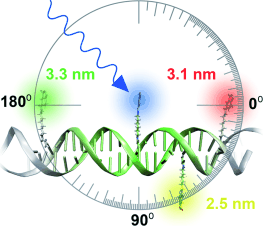Molecular Ruler Sets Bacterial Needle Length

March 16, 2015 – When a salmonella bacterium attacks a cell, it uses a nanoscopic needle to inject it with proteins to aid the infection. If the needle is too short, the cell won’t be infected. Too long, and the needle breaks. Now, University of Utah biologists report how a disposable molecular ruler can determine the length of the bacterial needle which will be just right.
The findings have potentially a long-term application for developing new antibiotics against salmonella and certain other disease-causing bacteria, for designing bacteria that could inject cancer cells with chemotherapy drugs, and for helping people design machines at the nanoscopic or molecular scale.
The University of Utah biology professor Kelly Hughes and doctoral student Daniel Wee is set for online publication the week of March 16 in the journal ‘Proceedings of the National Academy of Sciences’.
The bubonic plague bacterium, salmonella, shigella and plant pathogens, which are important pathogens, are like fire blight. They all use hypodermic-like needles which inject proteins that facilitate disease processes. Hughes said, “Our work says that there is one mechanism – the molecular ruler – to explain how the lengths are controlled for needles in gram-negative bacteria and for hooks on flagella [the U-joints in propellers bacteria use to move] in all bacteria.”
Why the findings matter
 Bacteria can help us build nanomachines and nanobots bacterial flagella – the nanoscopic motor-and-propeller system they use to swim to dinner or to targets – are the most sophisticated nanomachines in the universe. Swiss scientists are using the design of bacterial flagella as the basis for a nanobot that will be put inside the eye to do nanoscale surgery.
Bacteria can help us build nanomachines and nanobots bacterial flagella – the nanoscopic motor-and-propeller system they use to swim to dinner or to targets – are the most sophisticated nanomachines in the universe. Swiss scientists are using the design of bacterial flagella as the basis for a nanobot that will be put inside the eye to do nanoscale surgery.
A number of disease-causing bacteria also have injectisomes, which also are built of proteins, as are most structures in living organisms. “In the case of the needle, you have a structure that extends from the surface of the bacterium like a hypodermic,” Hughes says. “These needles are fragile. If one is too long, it will break off and be useless. If you make it too short, then it can’t get past the surface proteins on cells it needs to invade.”
By understanding how certain disease-causing bacteria build their injectisomes we may be able to develop new antibiotics to target and destroy the needles and thus deter bacterial infections. The rulers that help build flagella also might be attacked by drugs to prevent bacteria from reaching target cells. Hughes said, “so you can kill two birds with one stone by hitting the two machines at the same time.”
He says that approach might work against injectisome-equipped bacteria such as salmonella species that cause typhoid fever and food poisoning; shigella species that cause dysentery; the bubonic plague bacterium Yersinia pestis; disease-causing E. coli; sexually transmitted Chlamydia trachomatis; many plant pathogens; and Pseudomonas aeruginosa, which often infects burn patients and the lungs of cystic fibrosis patients.
Bacteria secrete a molecular ruler to measure needle length
Gram-negative, disease-causing bacteria “are very closely related species, so how do they subtly control the various needle lengths to be perfect? Well Hughes said, “in one case it might be 40 nanometers versus 55 nanometers. These are small sizes. So to do this, the bacteria developed molecular rulers to differentiate needles of different lengths.”
(Gram-negative bacteria are those with membranes lining both the inside and outside of their cell wall, while gram-positive bacteria have only an inner membrane.)
When needles are built by a bacterium, it first builds a base. (A series of proteins form a doughnut, and inside the doughnut hole, the actual secretion machine gets constructed,” Hughes says. “It’s the same for the flagella as it is for these needles.)
Next the proteins start assembling to form the needle or injectisome. Once amino acids at the bottom end of the ruler pass through the base of the needle, they tell the bacterium that the needle is long enough and to stop growing. They also tell the needle to inject virulence proteins into the target cell and the molecular ruler is ejected.
How the study was performed
Genetically engineered salmonella with seven ruler lengths were grown in a flask, their needles isolated, and the needle lengths measured under an electron microscope.
Previous studies found the molecular ruler determines the length of the hook or U-joint that helps turn flagella or propellers in many bacteria. Research also found the molecular ruler determines the length of both the flagellar hook and the needle in plague bacteria.
One theory holds that a molecular measuring cup in the needle’s base sends a cupful of needle components to assemble the needle, and the length of the needle is determined by the size of the cup.
Another theory says that as needle components assemble outside the needle’s base, a rod-shaped structure assembles inside the base to link the base and needle, and that when the rod is complete, needle assembly stops, thus determining needle length.






